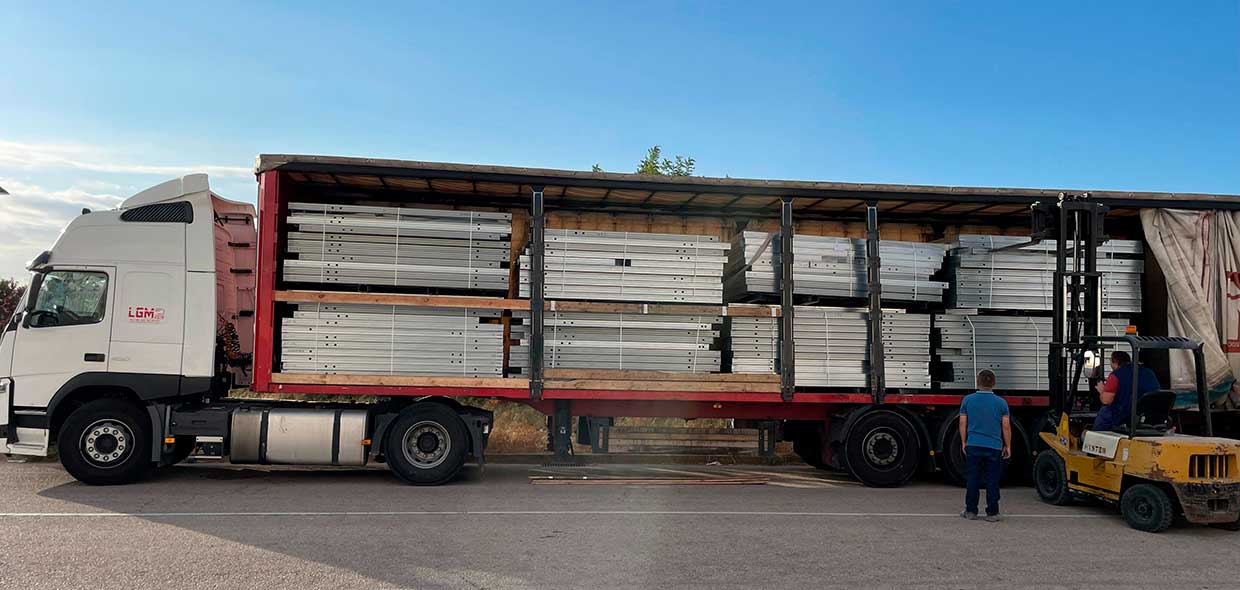Do you want to discover the reasons why STALART is the most sustainable option for your next construction project?
STALART is committed to leading the shift towards greener buildings, merging the sustainability of steel frame with the efficiency of construction in the controlled environment of a factory. This synergy not only eliminates waste during the construction phase but also marks a significant step in reducing the carbon footprint of the industry, demonstrating why this combination is not only superior to traditional construction methodologies but also essential for the future of a healthier planet.

230m² House Transported in Two Trucks to the Construction Site
1. Benefits of Manufacturing Structures with Steel Frame
Factory construction emerges as a crucial pillar for more sustainable building, noted for its ability to drastically reduce waste generation compared to traditional methods.
Through detailed and precise planning by our engineers, this approach ensures waste minimization from the design stage. Manufacturing building components in a controlled environment achieves superior precision and accuracy, which in turn reduces errors and the amount of waste generated. This process not only cuts down waste in the production phase but also on-site, contributing to a cleaner and more efficient environment.
– Reducing Transportation
One of the key advantages of factory construction is the significant reduction in the need for on-site transportation. By delivering only what is needed, when it is needed, we significantly reduce vehicle emissions associated with material transport, reinforcing our contribution to reducing the carbon footprint.
Our steel frame system is especially beneficial in minimizing transportation during the various phases of material storage, handling during the construction process, and supply to the site.
– Efficiency in Construction Time
The effectiveness of factory construction is evident in the acceleration of the construction process, achieving time reductions of 20% to 40% compared to conventional methods. This speed not only means fewer disruptions in the environment but also a reduced environmental impact during the construction phase.
– Reduction in Labor
Incorporating factory construction processes results in a significant reduction in the need for on-site labor, achieving reductions of up to 60%. This approach not only optimizes the construction process but also contributes to a safer and more managed work environment.
2. The Transformative Impact of Steel Frame on Sustainable Construction
The adoption of steel frame structures is a powerful strategy for reducing resource consumption in construction. This material not only stands out for its combination of strength, lightness, durability, and recyclability but also redefines sustainability standards in the sector.
– Efficiency and Strength:
Steel frame is notable for its unprecedented strength-to-weight ratio, which allows achieving the necessary structural integrity with less material. This approach not only increases project efficiency but is also key to reducing global resource consumption.
– Recyclability:
With a recycling rate close to 90%, steel stands as one of the most sustainable materials. This contrasts sharply with wood, whose recyclability is more complex, especially if treated, not to mention that its combustion releases CO2. Therefore, steel frame stands out for its ecological advantages.
– Ease of Dismantling:
Intentionally designed for easy dismantling, steel frame structures promote a dry construction model, which facilitates assembly and disassembly while minimizing waste generation. This approach is not only sustainable but also reduces the lifecycle cost of the project.
– Environmental Benefits:
The implementation of steel frame-based solutions offers the possibility of significantly reducing the construction sector’s carbon footprint. Research suggests that these practices could reduce the construction carbon footprint by 44% by 2050.
Opting for steel frame structures promotes more efficient resource use and less waste production, leading the construction sector toward a greener and more eco-friendly future.
3. Revolutionizing the Industry with Steel Frame
With the construction industry as one of the largest contributors to global carbon emissions—accounting for nearly 39% of them—and a major consumer of natural resources, the urgency to innovate towards more sustainable practices is clear. Habitat degradation, biodiversity loss, and soil disturbances are just some of the consequences of conventional practices.
The implementation of steel frame is presented as one of the most effective strategies to reduce these emissions, aligning with the European Union’s goals of cutting waste generation by 30% by 2030.
4. A Carbon-Neutral Steel Future
Our commitment to sustainability extends to the selection of materials, opting for Arcelor Mittal’s Magnelis steel for our structures, known for its commitment to reducing the carbon footprint. Today, it is already viable, through initiatives like xCarb™, to have materials certified as zero emissions, allowing companies like STALART to continue leading the way to a greener steel future, offering products that significantly reduce CO2 emissions.
Building with STALART is not just a choice for efficiency and sustainability; it is a step towards protecting the planet for future generations.

“Building has never been easier”

